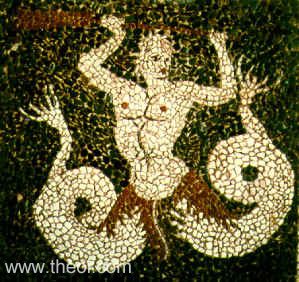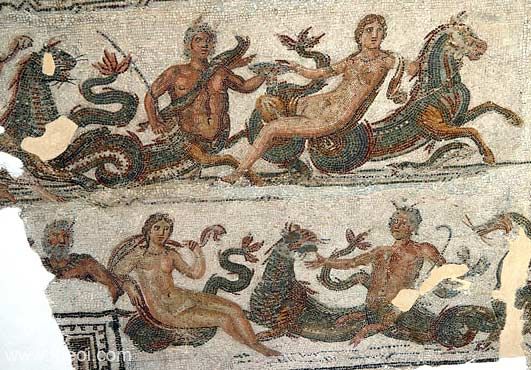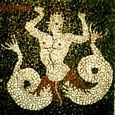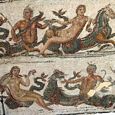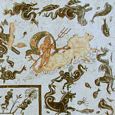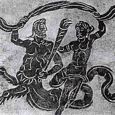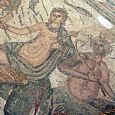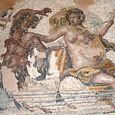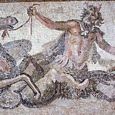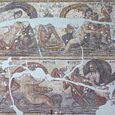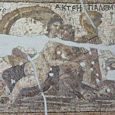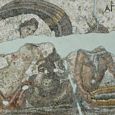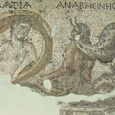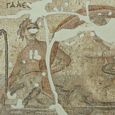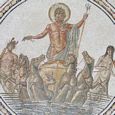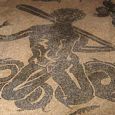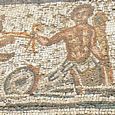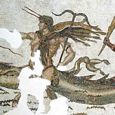TRITONS (Tritones) - Mermen Sea-Gods of Greek Mythology (original) (raw)
Greek Mythology >> Bestiary >> Tritons (Tritones)
Greek Name
Τριτων Τριτονες
Transliteration
Tritôn, Tritones
Latin Spelling
Triton, Tritoni
Translation
Of the Third (tritos)
Double-tailed Triton, Greek mosaic C2nd B.C., Sparta Archaeological Museum
THE TRITONES (Tritons) were a group of fish-tailed sea-gods or daimones in the train of the god Poseidon. They were a plurification of the god Triton and were portrayed as the Satyroi (Satyrs) of the sea.
Another breed of Tritones, named Ikhthyokentauroi (Sea-Centaurs), had the upper bodies of men and the lower bodies of Hippokampoi (fish-tailed horses).
A monstrous Triton-like creature was also described by several ancient writers. The most famous of these was a dead specimen preserved in the town of Tanagra.
FAMILY OF THE TRITONS
PARENTS
Probably TRITON or POSEIDON though nowhere stated
ENCYCLOPEDIA
TRITON (Tritôn). A son of Poseidon and Amphitrite (or Celaeno), who dwelt with his father and mother in a golden palace on the bottom of the sea, or according to Homer (Il. xiii. 20) at Aegae. (Hes. Theog. 930, &c.; Apollod. i. 4. § 6.) Later writers describe this divinity of the Mediterranean as riding over the sea on horses or other sea-monsters. (Ov. Heroid. vii. .50; Cic. de Nat. Deor. i. 28; Claudian, xxviii. 378.) Sometimes also Tritons are mentioned in the plural, and as serving other marine divinities in riding over the sea. Their appearance is differently described, though they are always conceived as presenting the human figure in the upper part of their bodies, while the lower part is that of a fish. Pausanias (ix. 21. § 1) says : the Tritons have green hair on their head, very fine and hard scales, breathing organs below their ears, a human nose, a broad month, with the teeth of animals, sea-green eyes, hands rough like the surface of a shell, and instead of feet, a tail like that of dolphins. (Comp. Orph, Hymn 23. 4 ; Plin. H. N. xxxvi. 4, 7.) The chief characteristic of Tritons in poetry as well as in works of art is a trumpet consisting of a shell (concha), which the Tritons blow at the command of Poseidon, to soothe the restless waves of the sea (Ov. Met. i. 333), and in the fight of the Gigantes this trumpet served to frighten the enemies. (Hygin. Poet. Astr. ii. 23; comp. Paus. viii. 2. § 3; Mosch. ii. 20; Virg. Aen. x. 209, &c.; Ov. Met. ii. 8; Plin. H. N. ix. 5.) Tritons were sometimes represented with two horse's feet instead of arms, and they were then called Centaur-Tritons or Ichthyocentaurs. (Tzetz. ad Lyc. 34, 886, 892.) Their figures are frequently mentioned in works of art, as in the sanctuary of Poseidon on the Corinthian isthmus (Paus. ii. 1. § 7), in the temple of Dionysus at Tanagra (ix. 20. § 4; comp. Aelian, H. A. xiii. 21), in the pediment of the temple of Saturn at Rome. (Macrob. Sat. i. 8.)
Source: Dictionary of Greek and Roman Biography and Mythology.
CLASSICAL LITERATURE QUOTES
Tritons and Nereids, Greco-Roman mosaic from Utica, Bardo National Museum
Orphic Hymn 24 to the Nereids (trans. Taylor) (Greek hymns C3rd B.C. to 2nd A.D.) :
"[The Nereides] fifty inspired Nymphs of the Sea (Nymphai Einalioi), who through the main delight to follow in the Tritones' (Tritons') train, rejoicing close behind their arms to keep."
Aelian, On Animals 14. 28 (trans. Scholfield) (Greek natural history C2nd A.D.) :
"When Poseidon drove his chariot over the waves, alltogether great fishes as well as dolphins and Tritones (Tritons) too, sprang up from their deep haunts and gambolled and danced around the chariot, only to be left utterly and far behind by the speed of his horses."
Pausanias, Description of Greece 3. 18. 10 - 16 (trans. Jones) (Greek travelogue C2nd A.D.) :
"[Illustrated on the throne of the statue of Apollon at Amyklai (Amyclae) in Lakonia (Laconia) :] On the left stand Ekhidna (Echidna) and Typhos (Typhon), on the right Tritones (Tritons)."
[N.B. The serpent-tailed Typhon and Ekhidna were balanced against the fish-tailed Tritones in this work of art.]
Pausanias, Description of Greece 2. 1. 7 :
"On the temple [of Poseidon at Korinthos (Corinth)], which is not very large, stand bronze Tritones (Tritons)."
Pausanias, Description of Greece 8. 2. 7 :
"I have also heard . . . that the Tritones (Tritons) speak with human voice, though others say that they blow through a shell that has been bored."
Philostratus the Elder, Imagines 1. 25 (trans. Fairbanks) (Greek rhetorician C3rd A.D.) :
"[From a description of an ancient Greek painting :] By act of Dionysos the earth of the Andrians is so charged with wine that it bursts forth and send up for them a river . . . and if one goes alone past the land and these drinking groups on it, he comes at length on Tritones (Tritons) at the river's mouth, who are dipping up the wine in sea-shells. Some of it they drink, some they flow out in streams, and of the Tritones some are drunken and dancing. Dionysos also sails to the revels of Andros and, his ship now moored in the harbour, he leads a mixed throng of Satyroi (Satyrs) and Bakkhantes (Bacchantes) and all the Seilenoi (Silens)."
Seneca, Troades 199 ff (trans. Miller) (Roman tragedy C1st A.D.) :
"The tranquil waters lie motionless, the wind has given up its threats, the calm sea murmurs with gentle waves, from the deep the band of Tritones (Tritons) has sounded the wedding hymn [for the ghost of Akhilleus (Achilles), son of the sea-goddess Thetis]."
Statius, Thebaid 1. 55 ff (trans. Mozley) (Roman epic C1st A.D.) :
"[In the train of Neptune-Poseidon] the winds and tempest are silent and with tranquil song proceed the Tritones (Tritons) who bear his armour and the rock-like Sea-Monsters (Cete) and the Tyrrhenian herds [seals], and gambol around and blow him, saluting their king."
Valerius Flaccus, Argonautica 1. 678 ff (trans. Mozley) (Roman epic C1st A.D.) :
"Thou, Father [Neptune-Poseidon], standest terrible to view with thy chariot and horses, while on either side a huge Triton holds the reins."
Apuleius, The Golden Ass 4. 31 ff (trans. Walsh) (Roman novel C2nd A.D.) :
"Then she [Venus-Aphrodite] made for the nearest shore lapped by the waves . . . her retinue in the deep performed her wishes . . . Nereus' daughters [the Nereides] appeared in singing chorus . . . Bands of Tritoni (Tritons) sported here and there on the waters, one softly blowing on his echoing shell, another fending off with silk parasol the heat of the hostile sun, a third holding a mirror before his mistress's face, while others, yoked in pairs to her chariot, swam below. This was the host of Venus' companions as she made for the Oceanus."
Nonnus, Dionysiaca 6. 257 ff (trans. Rouse) (Greek epic C5th A.D.) :
"The sea rose [during the great deluge] until Nereides became Oreiades on the hills over the woodland . . . The dripping Tritones (Tritons) at the edge of a secret wood wagged their green forked tails against their flanks, and hid in the mountain vaults where Pan had his habitation, leaving their familiar speckled conchs to sail about with the winds . . . Nereides in battalions swam over the flooding waves; Thetis travelled over the water riding on the green hip of a Triton with broad beard."
Nonnus, Dionysiaca 43. 81 ff :
"[When Poseidon led the Sea-Gods into battle against Dionysos and his allies :] Poseidon replied [to Dionysos] in threatening tones : ‘ . . . Up, my dear Tritones (Tritons), help--tie up the Bakkhantes (Bacchantes) and make them seafarers!’"
ANCIENT GREEK & ROMAN ART
Z34.2 Double-Tailed Triton
Greek Sparta Floor Mosaic C2nd B.C.
Z34.10 Tritons & Nereids
Greco-Roman Utica Floor Mosaic A.D.
Z2.9 Poseidon & Tritons
Greco-Roman Ostia Floor Mosaic A.D.
Z33.7A Triton & Nereid Nymph
Greco-Roman Ostia Floor Mosaic A.D.
Z33.8 Triton & Leucothea
Greco-Roman Piazza Amerina Mosaic C4th A.D.
Z33.6 Triton & Nereid Nymph
Greco-Roman Villa Sileen Floor Mosaic A.D.
Z34.1 Triton & Hippocamp
Greco-Roman Antioch Floor Mosaic C3rd A.D.
Z34.4A Tritons & Nereids
Greco-Roman Antioch Floor Mosaic C4th A.D.
Z34.4B Triton, Nereid, Palaemon
Greco-Roman Antioch Floor Mosaic C4th A.D.
Z34.4D Triton Agreus & Nereid
Greco-Roman Antioch Floor Mosaic C4th A.D.
Z34.4E Triton Anaresineos
Greco-Roman Antioch Floor Mosaic C4th A.D.
Z34.4F Triton Gaaeos & Nereid
Greco-Roman Antioch Floor Mosaic C4th A.D.
Z2.4 Poseidon & Tritons
Greco-Roman Chebba Floor Mosaic C2nd A.D.
Z34.7 Double-Tailed Triton
Greco-Roman Herculaneum Mosaic C1st A.D.
Z34.8 Triton & Leocamp
Greco-Roman Volubilis Floor Mosaic A.D.
Z34.3B Triton & Phorcys
Greco-Roman Acholla Floor Mosaic A.D.
SOURCES
GREEK
- Pausanias, Description of Greece - Greek Travelogue C2nd A.D.
- The Orphic Hymns - Greek Hymns C3rd B.C. - C2nd A.D.
- Philostratus the Elder, Imagines - Greek Rhetoric C3rd A.D.
- Nonnus, Dionysiaca - Greek Epic C5th A.D.
ROMAN
- Seneca, Troades - Latin Tragedy C1st A.D.
- Valerius Flaccus, The Argonautica - Latin Epic C1st A.D.
- Statius, Thebaid - Latin Epic C1st A.D.
- Apuleius, The Golden Ass - Latin Novel C2nd A.D.
OTHER SOURCES
Other references not currently quoted here: Pliny Natural History 9.5 & 36.4, Tzetzes on Lycophron 34 & 886 & 892.
BIBLIOGRAPHY
A complete bibliography of the translations quoted on this page.
